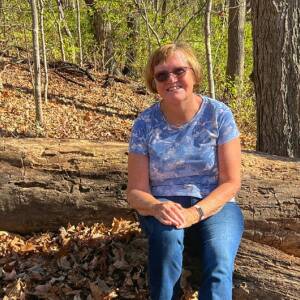American bison
Thursday
After watching some of the tennis from Wimbledon first thing, we left late morning and drove down to Big Bone Lick State Park in Kentucky. It’s only about a 55 minute drive, yet we had never been.
During the Pleistocene Epoch, over 15,000 years ago, a huge ice sheet covered the ground all the way from Canada down to the Ohio River. On the edges of this ice sheet, great herds of giant mastodons, wooly mammoths and giant sloths were attracted to the warm salt springs that were found in this area. The salty marsh that attracted these prehistoric beasts sometimes proved to be a fatal attraction. Animals became trapped and perished in what the early pioneers called "jelly ground," leaving an extraordinary concentration of skeletons and interesting clues about life in prehistoric Kentucky. The fossilized remains of these prehistoric animals were first discovered in 1739 and have since been worked over thoroughly by collectors and scientists, and their findings are now displayed extensively at museums throughout the world.
In the early 1800s when Meriwether Lewis was en route to St.Louis to begin his memorable journey to the Pacific Ocean with William Clark, he stopped at Big Bone Lick and sent bone samples to President Thomas Jefferson. Later, on orders from Jefferson, who wanted more samples and scientific information gathered at this place, William Clark and his brother George Rogers Clark came back for a detailed exploration of Big Bone Lick. This project by the Clark brothers led to Big Bone Lick being named “the birthplace of American paleontology.
As a living reminder of all the beasts that passed this way, including some of their ancient ancestors, the park has maintained a small bison herd since the 1990’s.
We first visited the small visitor center, then went to see the bison. We got talking to one of the employees, a retired history teacher - he retired from teaching quite early, and is now a full time employee at the park. We were the only people around at the time, so we had his full attention. He told us they have 1 bull and 8-10 females. The bull is around 30 years old, getting towards normal life expectancy, but obviously still performing his role, as there were four young ones, between the ages of 7 weeks and three months. Five had been born, but unfortunately one didn’t survive. The females are younger, round about 7-10 years. We remained chatting and watching them for a while, then the guy pointed out the “lead” female was heading towards the wooded part of their enclosure as the temperatures rose, and we would soon lose sight of them, so we timed our visit perfectly. We then headed out on the trails - nothing outstanding, just through forest, but one of them, a shorter interpretive trail (with information panels at intervals) did take you past one of the salt springs, which aren’t much to look at nowadays as the water table has dropped. Altogether it made a very interesting outing.
When we got home, Roger went off for a cooling swim, but I stayed home. Later we went to our favourite outdoor shop REI to look for a few things, then we went out for dinner to a favourite fish restaurant nearby.

Comments
Sign in or get an account to comment.


